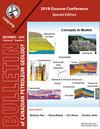Stratigraphic Framework and Depositional Controls on Reservoir Occurrence, Big Valley Formation, Southern Alberta
Q3 Earth and Planetary Sciences
引用次数: 3
Abstract
Abstract Within the past decade, the Big Valley and Exshaw formations in southern Alberta have received significant interest as a potential unconventional oil play because of the overwhelming exploration/exploitation success in the stratigraphically-equivalent Three Forks and Bakken formations in Saskatchewan, Manitoba and North Dakota. Because of continuous industry hype, this upper Devonian-lower Mississippian succession came to be known as the “Alberta Bakken”. Such a term suggests potentially prolific oil production from a reservoir similar to the Bakken in Saskatchewan. In fact the term “Alberta Bakken” is misleading since to date there has been only moderate oil production from localized carbonate reservoirs in the Big Valley Formation, and from very fine-grained sandstones and siltstones of the Mississippian Lower Banff Formation. Reservoir development in the Big Valley Formation is stratigraphically and areally restricted by both depositional facies controls and post-depositional early diagenetic, subaerial and structural-collapse processes. Detailed lithofacies analysis indicates that the Big Valley Formation is divisible into two units: an upper shallow marine limestone and a lower hydrocarbon-bearing, partially dolomitized, peritidal carbonate. The peritidal unit, in turn, is divisible into four lithofacies: peloidal packstone-grainstone (the primary oil-bearing lithofacies), microbial laminite, laminated dolomudstone and intraclastic breccia-laminite. Regionally, each lithofacies is discontinuous and in the order of 0.5 to 2.0 m thick. Locally, however, the peloidal packstone-grainstone attains thicknesses of up to 8 m, forming isolated oil-producing reservoirs. These over-thickened zones correspond to specific areas of Big Valley Formation ‘thicks’, which tend to align with a NNW-SSE trending ‘basement’ lineament that underlies the study area. It is equivocal whether this structural trend is basement-controlled, or reflects dissolution of salt beds along the margin of an underlying evaporite basin. Successful exploration in the Big Valley Formation appears to depend on whether the over-thickened areas can be located.阿尔伯塔南部大河谷组地层格架及储层产状的沉积控制
在过去的十年里,由于在萨斯喀彻温省、马尼托巴省和北达科他州的地层相同的Three Forks和Bakken地层中取得了压倒性的勘探/开发成功,阿尔伯塔省南部的Big Valley和Exshaw地层作为一个潜在的非常规油区受到了极大的关注。由于持续的工业炒作,这个上泥盆统-下密西西比统的演替被称为“阿尔伯塔巴肯”。这一术语表明,类似于萨斯喀彻温省Bakken油田的油藏可能具有丰富的石油产量。事实上,“Alberta Bakken”一词具有误导性,因为到目前为止,在Big Valley组的局部碳酸盐岩储层以及密西西比Lower Banff组的非常细粒度的砂岩和粉砂岩中,只有适度的石油产量。大河谷组的储层发育在地层和区域上均受到沉积相控制和沉积后早期成岩作用、陆上作用和构造崩塌作用的制约。详细的岩相分析表明,大谷组可划分为两个单元:上部浅海相灰岩单元和下部含油气的部分白云化潮旁碳酸盐岩单元。潮周单元又可划分为4个岩相:环面砾岩-颗粒岩(原生含油岩相)、微生物纹层岩、层状白云岩和碎屑内角砾岩-纹层岩。区域上各岩相不连续,厚度在0.5 ~ 2.0 m之间。然而,在局部地区,样面砾岩-颗粒岩厚度可达8米,形成孤立的产油油藏。这些过厚带对应于大峡谷组“厚”的特定区域,这些区域往往与研究区域下方的NNW-SSE走向的“基底”线相一致。这种构造倾向是基底控制的,还是反映了下伏蒸发岩盆地边缘盐层的溶解作用,目前尚不清楚。大河谷组勘探的成功与否似乎取决于是否能找到过厚的区域。
本文章由计算机程序翻译,如有差异,请以英文原文为准。
求助全文
约1分钟内获得全文
求助全文
来源期刊

Bullentin of Canadian Petroleum Geology
Earth and Planetary Sciences-Geochemistry and Petrology
CiteScore
2.50
自引率
0.00%
发文量
0
期刊介绍:
The Bulletin of Canadian Petroleum Geology is a peer-reviewed scientific journal published four times a year. Founded in 1953, the BCPG aims to be the journal of record for papers dealing with all aspects of petroleum geology, broadly conceived, with a particularly (though not exclusively) Canadian focus. International submissions are encouraged, especially where a connection can be made to Canadian examples.
 求助内容:
求助内容: 应助结果提醒方式:
应助结果提醒方式:


